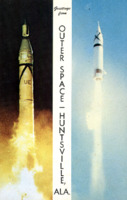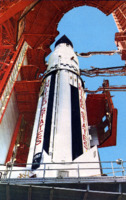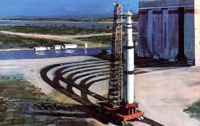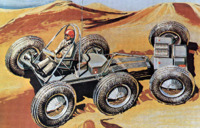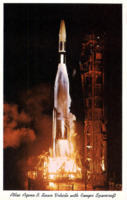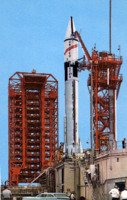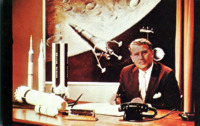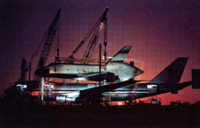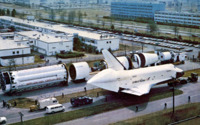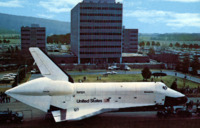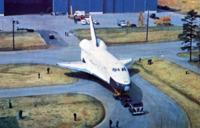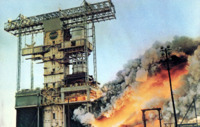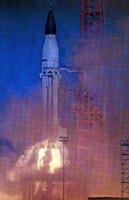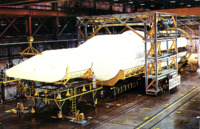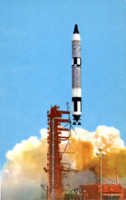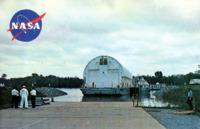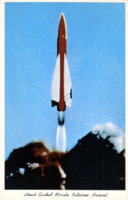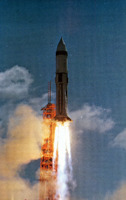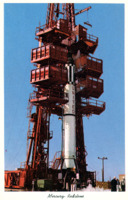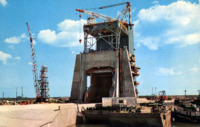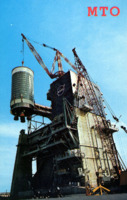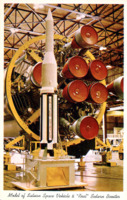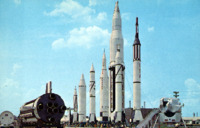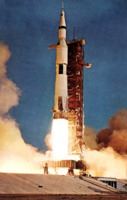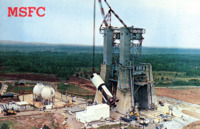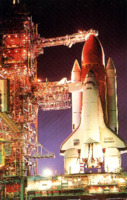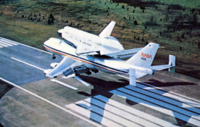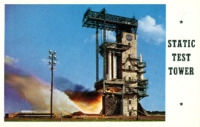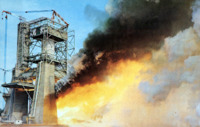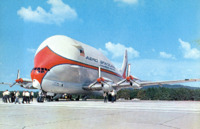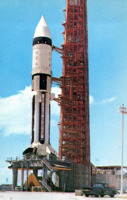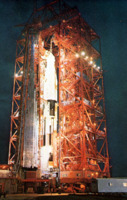
Browse Items (38 total)
Sort by:
-
"Greetings from Outer Space - Huntsville, Ala."
Front: Greetings from Outer Space, Huntsville, Ala.
Back: JUPITER-C
left: U.S. Army JUPITER-C Missile. This rocket, developed at the Army Ballistic Missile Agency, Huntsville. Ala., was used to launch the free world's first scientific earth satellite, the EXPLORER.
Right: U.S. Army JUPITER Missile. The JUPITER Intermediate Range Ballistic Missile is being developed at the Army Ballistic Missile Agency, Huntsville. Ala. It is capable of carrying a nuclear warhead to a distance of 1500 nautical miles. -
"NASA'S SA-5 undergoing pre-lounch check-out."
Back: NASA'S SA-5 undergoing pre-launch check-out. The Saturn is the free-world's largest space booster. It develops a million and a half pounds thrust. The NASA Marshall Space Flight Center at Huntsville. Alabama, has been developing and providing rockets for our space achievements since the very beginning of our entry into this field. -
Artist's Conception of Saturn V Flight
Back: This is on artist's conception of the Apollo/Saturn V vehicle leaving on the first leg of the moon journey. The three stage vehicle will be launched from Cape Kennedy, Fla. and will carry three astronauts to the moon and back. The Saturn was developed at MSFC, Huntsville, Alabama. -
Artist's Conception of Saturn V/Apollo Being Transported on Crawler
Back: Artist's conception of Saturn V/Apollo being transported on crawler the size of a baseball infield, to the launch area at Mila, John F. Kennedy Space Center. The NASA Marshall Space Flight Center at Huntsville, Alabama, has been developing and providing rockets for our space achievements since the very beginning of our entry into this field. -
Artist's Drawing of Proposed Lunar Vehicle
Back: This is on artist's drawing of the six wheel General Motors built Mobility Test Article. The vehicle is being built by GM and tested by NASA. The concept will be used to design a vehicle for use on the moon. MSFC, at Redstone Arsenal, directs the work. -
Atlas Agena-B Space Vehicle with Range Spacecraft
Front: Atlas Agena-B Space Vehicle with Ranger Spacecraft
Back: ATLAS AGENA-B SPACE VEHICLE WITH RANGER SPACECRAFT
The Atlas Agena-B space vehicle it shown here with its Ranger spacecraft payload on the pad at Cape Canaveral. Fla. The Atlas Agena-B is being used by NASA to launch the 750-pound Ranger lunar impact missions. The Atlas Agena-B program is managed by the NASA Marshall Space Flight Center, Huntsville, Alabama. -
Centaur II undergoes pre-launch tests
Back: Centaur II, our first space vehicle to use liquid hydrogen as a propellent, undergoes pre-launch tests.
The NASA Marshall Space Flight Center at Huntsville, Alabama, has been developing and providing rockets for our space achievements since the very beginning of our entry into this field. -
Dr. Wernher von Braun
Back: Dr. Wernher von Braun, director of the NASA - Marshall Space Flight Center, is shown with rocket models and hardware at the Huntsville, Alabama space installation. -
Enterprise Being Unloaded from 747 Carrier
Back: Enterprise being unloaded from 747 Carrier. -
Enterprise Passing a Saturn 1B
Back: The Old and the New, Enterprise passing a Saturn 1B. -
Enterprise Passing Marshall Space Flight Center Headquarters
Back: Enterprise passing Marshall Space Flight Center Headquarters. -
Enterprise's Home for 1978
Back: Enterprise's home for 1978. -
F-1 Engine
An F-1 engine, generating 1.5 million pounds thrust, is captive fired at the NASA-Marshall Space Flight Center, Huntsville, Alabama. The liquid oxygen/RPl (kerosene) engine is used on the Saturn V booster. -
Fifth Saturn I Launch at Cape Kennedy
Back: The fifth Saturn I launch vehicle (SA-5) leaves the launch pad at Cape Kennedy, Fla., on Jan. 29, 1964. Nose cone painted black for special thermal experiment. -
First Flight Configuration of the Saturn C-1
Back: The first flight configuration of the giant Saturn C-1 rocket is seen at the George C. Marshall Space Flight Center, N.A.S.A. Huntsville, Ala. The C-1 will be capable of placing about 10 tons into low earth orbit. -
Gemini - Titan I Lifting Off Launching Pad
Back: Gemini-Titan 1 lifting off launching pad on its maiden voyage, testing spacecraft and vehicle. The Gemini is the first of NASA's two-man spacecrafts. The NASA Marshall Space Flight Center at Huntsville, Alabama, has been developing and providing rockets for our space achievements since the very beginning of our entry into this field. -
George C. Marshall Space Flight Center
Back: The George C. Marshall Space Flight Center (MSFC), Huntsville, Alabama
Saturn rocket booster barge at dock on Tennessee River. Barge is used to carry boosters from MSFC at Redstone Arsenal, Ala., to NASA - Kennedy Space Center, Fla., for launch. -
Hawk Guided Missle
Front: Hawk Guided Missile, Redstone Arsenal.
Back: HAWK GUIDED MISSILE, REDSTONE ARSENAL, HUNTSVILLE, ALABAMA
This it the Army's versatile surface-to-air guided missile, designed for protection against low altitude attack. Carrying a lethal warhead, this air defense weapon system is capable of destroying attackers flying at the lowest altitudes, at ranges insuring effective protection of defended areas. Highly mobile, the system is capable of being transported with a minimum number of vehicles on the highway, by helicopter, and by aircraft. -
Launch of Saturn I
Back: The second Uprated Saturn I launch vehicle (designated AS-203) leaves the launch pod at Cape Kennedy, Fla., on July 5, 1966. Saturn was developed at MSFC, Huntsville, Alabama. -
Mercury Redstone
Front: Mercury Redstone
Back: National Aeronautics and Space Administration's "Mercury-Redstone" being readied for launch at the Cape Kennedy launch site. The rocket was provided by the NASA George C. Marshall Space Flight Center, Huntsville, Alabama. -
Michoud Assembly Facility
Back: This is the assembly floor at the NASA - Michoud Assembly facility at New Orleans, La. The large assembly building has some 40 acres under one roof. Boosters shown here are first stages for the Uprated Saturn I launch vehicle. The Saturn was developed at Marshall Space Center, Huntsville, Alabama. -
Mississippi Test Facility
Back: MISSISSIPPI TEST FACILITY, NATIONAL AERONAUTICS AND SPACE ADMINISTRATION, HANCOCK COUNTY
This 200-foot-tall rocket test tower is one of three units and this particular stand is for static firing the S-ll (second stage) of the giant Saturn V. MTF is a division of the George C. Marshall Space Flight Center, Huntsville, Alabama. -
Mississippi Test Operations Test Stand
Front: MTO
Back: A ground test modal of the Saturn V second stage (S-ll ) is lifted into a recently completed captive test stand at the Mississippi Test Operations in Hancock County, Miss. The NASA-Marshall Space Flight Center's Mississippi Test Operations will be used for captive firing the S-ll flight stages. Ground test stage was manufactured to test out S-ll systems and the ground test facilities. -
Model of Saturn Space Vehicle & "Real" Saturn Booster
Front: Model of Saturn Space Vehicle & "Real" Saturn Booster.
Back: SCALE MODEL, SATURN SPACE VEHICLE AND "REAL" SATURN BOOSTER
A one-tenth scale model of the Saturn Space vehicle is shown here behind a "real" Saturn booster at the assembly area of the NASA Marshall Space Flight Center, Huntsville, Alabama. The big booster is capable of developing 1.5 million pounds thrust. An assembled vehicle stands 162 feet high. -
NASA Rocket Display
Back: Rocket display at N.A.S.A. Marshall Space Flight Center, Huntsville, Alabama. -
Preparations for Unloading Enterprise from 747 Carrier.
Back: Preparations for unloading Enterprise from 747 Carrier. -
Saturn I Launch
Front: Saturn I
Back: The eighth Saturn I launch vehicle launched from the NASA-Kennedy Space Center, Fla., (vehicle designated SA-9) is shown leaving the launch pad on Feb. 16,1965. The Saturn was developed at Marshall Space Center, HuntsviIle, Alabama. -
Saturn I Space Vehicle
Back: A Saturn I space vehicle, developed by the National Aeronautics and Space Administration's Marshall Space Flight Center. Huntsville, Ala., is launched from Cape Kennedy, Fla. The Saturn I weighs more than a million pounds at liftoff, and generates a maximum of 32,000,000 horsepower. It is a fore-runner of the Saturn V moon rocket being developed by MSFC. Huntsville. -
Saturn V Launch
Back: This Is the National Aeronautics and Space Administration's Apollo/Saturn V vehicle, used to place man on the moon. The Saturn V vehicle, developing 7.6 million pounds thrust, was developed under the direction of the NASA-Marshall Space Flight Center, Huntsville, Ala. -
Saturn V Test Stand
Front: MSFC
Back: The first flight Saturn V booster is shown being hauled into a giant test stand at NASA - MarshalI Space Flight Center, Huntsville, Alabama (Redstone Arsenal). The booster will be captive fired here. Stage's five F-1 engines produce 7.5 million pounds thrust. -
Space Shuttle Challenger Prior to Launch
Back: Kennedy Space Center, FL. Space Shuttle Challenger, Mission 41-B, on pad prior to launch. -
Space Shuttle Enterprise Lands at Redstone Arsenal Airfield March 13
Back: Space Shuttle Enterprise lands at Redstone Arsenal Airfield March 13, 1978. -
Space Vehicle - Made in Huntsville
Front: Saturn Space Vehicle - Made in Huntsville, Alabama.
Back: NATIONAL AERONAUTICS AND SPACE ADMINISTRATION'S "SATURN" - WORLD'S LARGEST KNOWN ROCKET LAUNCHED FROM CAPE CANAVERAL, FLORIDA ON OCTOBER 27, 1961. -
Static Firing Test Tower
Front: Static Test Tower.
Back: STATIC FIRING TEST TOWER, MARSHALL SPACE FLIGHT CENTER
The Saturn booster undergoes static firing at the NASA George C. Marshall Space Flight Center, Huntsville, Alabama. The booster has been successfully static fired many times prior to the launching of the first Saturn from Cape Canaveral, Florida on October 27, 1961. The same tower has been used for Redstone and Jupiter programs. Static testing of a missile consists of locking the missile into place on the stand and firing it. The missile does not "take off", but as it strains against the mighty grip of the great tower its roaring engine can be studied for performance characteristics as if it were actually in flight. -
Static Test of Saturn V First Stage
Back: The 7.5 million pound thrust Saturn V first stage is static tested at the NASA-Marshall Space Flight Center in Huntsville, Ala. Five F-l engines power the stage. The stage will be the booster for the first Saturn V launched. This vehicle is scheduled for launch this year (1967). -
Super Guppy Aircraft
Back: Super Guppy aircraft, operated under NASA contract and owned by Aero-Space Lines, Inc., Van Nuys, Calif. Used to haul Saturn S-IVB stage from West Coast to Cape Kennedy. Also used to carry other large rocket stages and components. -
Uprated Saturn I Launch at Cape Kennedy
Back: The second Uprated Saturn I launch vehicle (designated AS-203) stands on the launch pad at Cape Kennedy. Blunt nosecone replaced the Apollo spacecraft for this special flight. This was a liquid hydrogen test to determine how liquid hydrogen reacted in space. Television comeras were in the top of the second stage's liquid hydrogen tank. The Saturn was developed at MSFC, Huntsville, AIabama. -
Uprated Saturn I Launch Vehicle
Back: The Uprated Saturn I launch vehicle (SA-202) is surrounded by the service structure on the launch pad at the NASA - Kennedy Space Center, Fla. The Marshall Center, Huntsville, Ala., developed the Saturn launch vehicle.
